A garage door that won’t open and close properly. There could be several reasons for this, such as worn-out rollers, misaligned tracks, or even faulty sensors and so on. If you’re having trouble with your garage door sticking, here are some reasons why your garage door sticks, along with ways to fix them.
Read More: Garage Door Opens Partially Then Stops – Causes & Repair
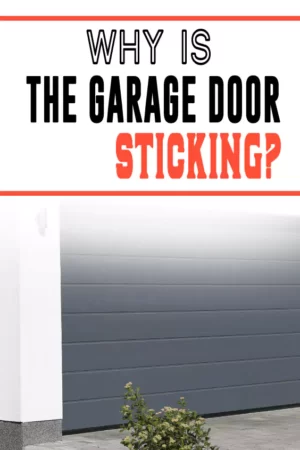
Why is the garage door sticking?
1. Misaligned door track
Age is the most prevalent cause of a misaligned garage door track (The Best Way to Raise Garage Door Track). The door’s center of gravity fluctuates as the tracks are pulled and stretched over time, causing it to stick.
Another potential cause is the misuse of your door. If you frequently use your garage as an entrance/exit point in your home, your tracks will likely suffer from additional wear and strain.
You may want to consider making alternative entrances/exits.
2. Broken cables
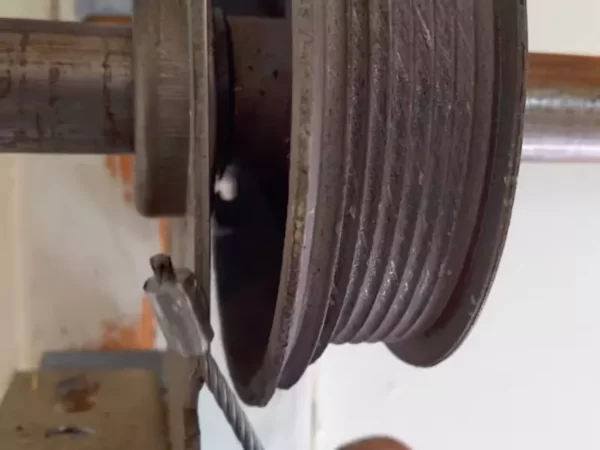
The cables that lift your garage door are a constant point of stress on any system. They are what propels your garage door up and down while also supporting its weight.
Over time, they can become weak and frayed due to wear and tear or damage from excessive use.
If your cable is damaged or shows signs of wear, then you should have it repaired as soon as possible.
3. Blocked remote signal
If your remote control gets interference, it can cause your garage door to stick.
Garage doors typically have a range of anywhere from 30 to 70 feet. So beyond that, your remote could be unable to communicate with your garage door opener.
To resolve this, first, check to see any obstructions, such as trees. If nothing is blocking its path, it might be a bad battery in your remote that needs to be replaced.
Be sure you have fresh batteries installed before giving up on your old ones.
4. Damaged springs
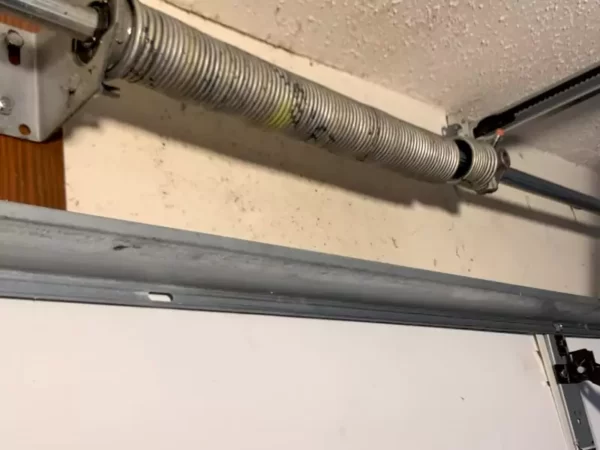
They are what lift your garage door off its track and hold it up in place. If your garage door spring breaks, one way to fix it is by manually lowering and raising it to see if it will lose connection.
If all else fails, you may need to entirely replace the broken spring or faulty track system. However, these repairs are better handled by professional garage door technicians.
5. No power connection to the operator
The motor that raises and lowers your garage door needs electricity to function. So be sure you have an intact power connection from your home’s main power panel to your garage door opener.
If there is no power, check for downed lines or blown breakers at your home’s main electrical panel. If everything checks out, it’s time to look for a wiring problem around your garage door.
3 common reasons for garage doors sticking to the floor
1. Uneven floor
If your garage door sticks to the floor, it’s likely because there are high spots or your garage has been built on a downslope. The leading cause would be that either you didn’t clean your drive or built an uneven concrete slab on it.
The floor on either side needs to be level for a smooth transition for an easy fix. So check both sides of your garage and driveway for uneven spots and fill them in with some dirt or gravel as needed.
Also, building a swing-out garage door can solve this problem.
2. Broken rollers
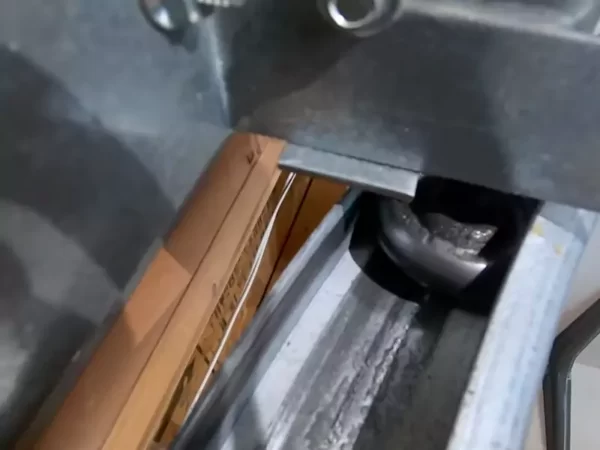
When your garage door sticks to the floor, one of the causes could be a broken roller. Rollers are an essential part of any automatic garage door system.
They are in charge of converting your manual movement into an electric signal. As a result, this moves a heavy object like a garage door through tracks or rails.
3. Unbalanced weight of garage door
Often, garage doors become unbalanced because of repeated door closings and openings. The torsion spring of your garage door may have gradually lost tension due to regular usage and natural wear-and-tear.
If a side or a corner of your garage door stops working, your garage door may become out of balance.
An unbalanced garage door causes it to stick down while opening or closing due to uneven weight distribution across its panels. In such cases, you should call an expert for immediate repair services.
How to fix a garage door that sticks to the floor
Step 1: Identify the Problem
From time to time, many overhead doors stick to concrete. Before taking any action, you must understand why your door is sticking.
Many factors can contribute to garage door sticking, including weather, humidity, and mechanical wear.
Before step two, ensure that your power switch has been turned off. It makes sure no power goes through it while working on repairs.
Step 2: Replace broken parts
Not all garage doors are created equal, and for any to work at its best, you may need to replace broken parts periodically.
To do so, first, remove damaged parts from your garage door by unscrewing or unclipping them from their places.
Step 3: Clean tracks
When your garage door sticks to the floor, it could mean that dirt and debris are clogging its tracks. One of the first things to do is inspect and clean its tracks.
If they’re too dirty, debris can prevent your door from operating as well as it should.
An easy way to clean these tracks is with an old toothbrush, soapy water, or a vacuum.
Step 4: Grease rollers
Grease rollers can wear out and cause your overhead door sticks to concrete. It’s essential that you replace them as soon as they get worn down, or else you risk having your doors sticking permanently.
Additionally, you can hire someone who specializes in garage door repair.
Step 5: Tighten hinges
If your garage door isn’t swinging smoothly, it may be time to tighten up some of its hinges. Use a screwdriver or socket wrench to fix and turn each one by hand until it feels snug.
Step 6: Install torsion springs
If your garage door is going down but getting stuck on one of its sides before ultimately hitting the floor, you might need to replace your torsion springs.
Torsion springs help lift and support your garage door weight, and they can get damaged over time with regular use.
Here’s what If the garage door sticks in hot weather
If you’ve ever had your garage door stick when you open it on a hot day, then you know it can cause quite a bit of frustration.
In some cases, extreme heat can even damage your garage door hardware components.
When it does get too hot and humid, moisture builds up inside our garage, causing the doors to become extremely heavy. It becomes harder for your door springs and rollers to lift and push them open.
As a result, this can cause your garage door opener to slip out of place or jam.
However, a few simple adjustments can help prevent the garage door from sticking through the hot weather season. Here are some steps you should consider taking:
How to fix a garage door that sticks in hot weather
1. Keep your garage door closed
First off, if possible, keep your garage door closed as much as possible during scorching days.
Heat is one of the primary factors that cause rollers and tracks to seize up and freeze. It eventually causes them not to slide smoothly against each other.
If you must leave your garage door open on a sweltering summer day, make sure it has plenty of ventilation.
2. Regulate temperature
The summer sun can make your garage a furnace. One sure way to prevent the garage door from sticking is by keeping it cool.
Most garage doors come with temperature sensors, e.g., a thermal protector. It allows you to set different temperatures when the door is closed and open.
Make sure the temperature in your home is under 80 degrees. Otherwise, condensation will form around any moving parts making things worse.
3. Maintain proper lubrication
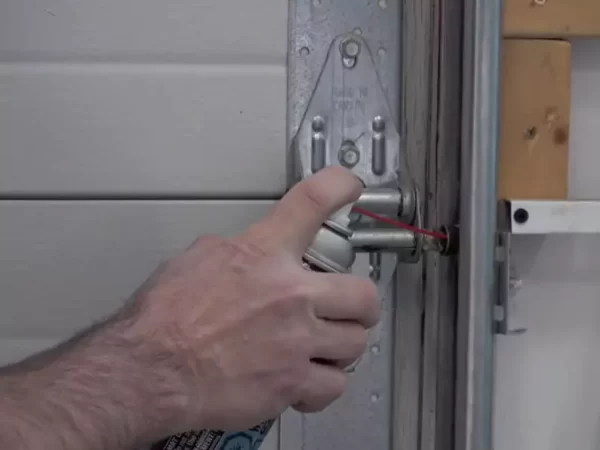
A garage door is often a large, heavy-moving object that requires frequent lubrication. Without sufficient lubrication, these moving parts will grind against each other, causing damage that may prove irreparable in no time at all.
If your rolling garage door sticks, check all the track rollers and hinges for excessive friction. You may need to use a wire brush or lubricant on them.
4. Replace extension springs
In hot weather, your garage door spring might become weak and loose. When you open your garage door, it will begin sticking due to heat temperatures, causing flexibility in your springs.
To prevent further stress on your spring, lubricate them properly, so they do not get damaged anymore or get them replaced.
What to do if the Garage door sticks after painting?
After painting your garage door, it’s expected that it may stick or bind when opening and closing. It may not be obvious why this happens, but there are several likely causes and ways to fix the problem.
More often than not, sticking may occur because painters didn’t clean thoroughly. Alternatively, they may have used paint remover instead of an oil-based primer before applying their final coats of paint.
All in all, the next section will explain ways to keep a garage door from sticking after painting.
How to fix a garage door that sticks after painting?
Tools and materials required
- Exterior Primer
- Spray Lubricant
- Flathead Screwdriver.
- Dusk mask
- A grit sanding block
- Rubber gloves
- Scraper
- Paint thinner
- Paint
- A roller applicator
Step 1: Remove the garage door panels
The first step is to remove both of your garage door panels. It will make it easier for you to access all of your hardware that needs to be cleaned and repainted.
Use the screwdriver to loosen each board, as they may have been painted and stuck together in many cases.
Step 2: Remove old paint
To remove old paint from a garage door, you need to sand it. You’ll want to use different courses of sandpapers, starting with fine-grit sandpaper and working your way downwards.
Sand all sections of your door in the same direction, so you don’t create an uneven surface.
Step 3: Clean with soap and water
This step is essential to ensure a clean surface for your new paint job. Wipe it down to remove debris, dirt, and stain.
Also, ensure that the door is completely dry after washing, as moisture can be one of the contributors to why your garage door won’t open after painting.
Step 4: Apply a prime coat
Applying a prime coat is essential as it seals any gaps or rough places that paint may otherwise open up. As a result, it makes the surface smoother for the new color.
Similarly, if you’re painting over metal, it’ll help fill in any dents and rust patches.
Step 5: Paint your door
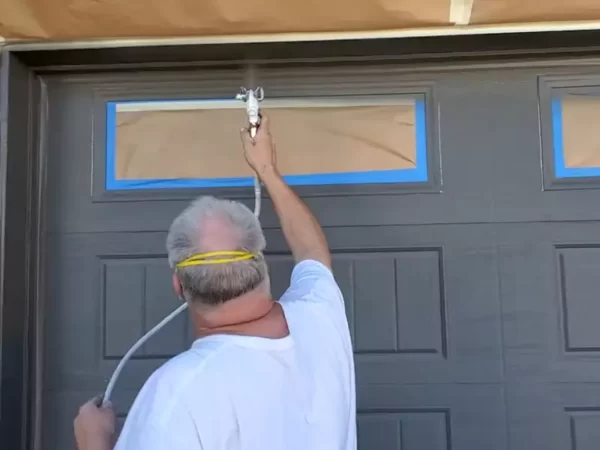
You want a nice, even coat on every inch of your door. You can quickly do this by using a quality roller applicator.
The critical factor here is that you must never open or close your garage door while it’s still wet. Opening/closing can cause new problems such as rusting metal/wood or peeling the paint.
Step 6: Test before replacing the panels
First, try to open and close your garage door manually. If it sticks, you need to remove any paint by sanding it down.
Use medium-grit sandpaper or a unique tool called a stripping disk. Be sure not to damage your underlying finish when doing so.
If it does not stick, know you have done a great job.
Why is the Garage door sticking to the weather seal?
Weather seals are an essential part of any door system as they help keep out water, wind, bugs, and other elements.
Additionally, they provide soundproofing to help with noise reduction and insulation to keep your home warmer in the wintertime.
However, they can become very brittle and crack apart, making your garage door stick. So here is a simple step guide on troubleshooting a stuck garage door on a weather seal.
How to fix a garage door that sticks to the weather seal
Step 1: Remove old weather seal
If your door weather seal has become torn or damaged, it can make your door difficult to close. To begin, check for rips and tears along with all the weather seals before removing any portions of it.
Then remove any old or damaged sections from around your garage doors.
Step 2: Cleaning the track
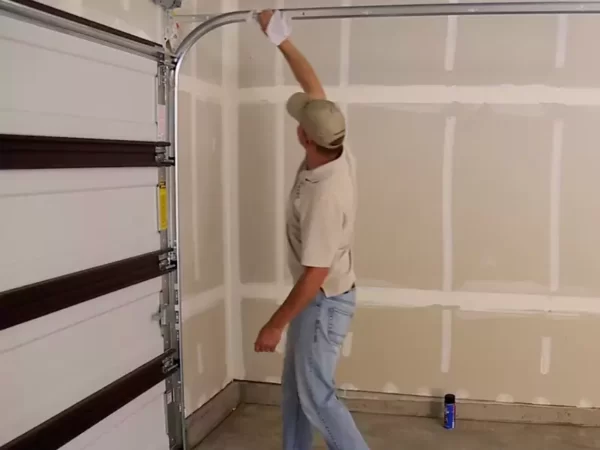
Pour some rubbing alcohol onto a clean, dry cloth and wipe down your garage door track. It will help loosen any grime that may be preventing your door from sealing.
Then rinse with warm water and let it air-dry. Make sure you are cleaning only one section of the weather seal at a time to avoid cross-contamination.
Step 3: Install new weather seal
To install your new weather seal, start at one end of your track and begin by gently tucking in one side of it. Then work slowly around, pushing and locking down each side as you work back toward where you started.
Be sure not to apply too much pressure, as doing so could tear or break your new weather seal. Also, don’t stretch out any areas as they can easily rip if pulled on.
Step 4: Secure the new weather seal
Finally, after you have installed your new weather seal, trim away any excess weather seal. If it’s curling up, you don’t need to leave as much seal. Use industrial strength glue or epoxy glue and put it on both sides of your garage door.
Let it sit for 15 minutes before putting anything on top of it, such as metal roofing panels.
Step 5: Finishing up & testing
After installing your new weather seal and curing it, test it by pulling up and down on it. You should not be able to pull it off or move it up and down with ease.
If so, apply more adhesive and let it cure until proper adhesion has been achieved.
But if sealed correctly, most garage doors will not leak air or water.
3 reasons for garage door sticking when first opening
Malfunctioning opener
One of the reasons your garage door is sticking when opening could be due to a malfunctioning opener. The whole point of a garage door opener is to lift and lower your door automatically.
Check for electrical issues such as a bad circuit or faulty wiring that can cause your garage door opener to fail.
It’s crucial, therefore, to have your electrical system regularly inspected to ensure that it’s up to code and operating correctly. Call a professional immediately to inspect and repair if you notice anything unusual.
Old or worn out rollers
Over time, rollers can get stretched out and start to sag, making them unable to handle even a lightweight door. Eventually, your door gets stuck when you try to open it.
The solution is to check your garage door rollers regularly. Look for rust, cracks, or other damage. Finally, to maintain smooth operation, ensure that they are properly lubricated.
Dirty tracks
Your garage door tracks accumulate dirt and debris, just like other parts of your garage door. Over time, your garage door becomes sticky, making it difficult to open with ease.
Luckily, there is an easy solution. Simply use a spray lubricant available at local home improvement stores, and spray your tracks.
Check this guide: Hiding Garage Doors Tracks Done
Let them sit for about ten minutes before attempting to open your door again. Alternatively, use a hose brush to scrub away any dirt that’s sticking between trolley joints and along-track rails.
How to fix a garage door that sticks when first opening
Step 1: Check all cables
If your garage door can’t open easily, check all your cables. It’s prevalent for wires to get tangled up, and it may just need a quick disentangling.
While doing so, look out for any cuts or worn-away portions on the cable. If there are damages, replace them as soon as possible.
Step 2: Engage the manual release
If your garage door can’t open, check whether you’ve engaged the manual release (also called emergency release). This small metal latch should be tucked in at one of your garage door panels.
If your garage door opener is engaged and works correctly, pulling on the manual release should activate it and open your door.
Step 3: Clean the keypad
Sometimes, your keypad not working as well as it should be could cause your garage door not to open. The keys can be unresponsive and may even take extra effort to press.
There could be any number of reasons for this – dusty contacts, worn-out keys, or something stuck under one of them.
To fix this, unplug your opener from its power source. Wipe it down with an all-purpose cleaner, and use something sturdy (like a screwdriver) to clean underneath each key on your pad. Put everything back together and see if you notice any change.
Step 4: Check the remote
Another reason why your garage door sticks when opened is a faulty remote. Your remote could have lost connection with the door opener.
It can be due to damaged batteries or simply a matter of poor connections.
To fix it, you’ll need to make sure all components are in good condition and try out new batteries if you haven’t already done so.
Step 5: Inspect the capacitor
A capacitor is located near or on your opener and is designed to help manage power from your home’s electrical system.
But over time and with heavy use, it can break down and lose its ability to supply enough electricity to your door opener.
To fix this, look for signs of damage, such as melted or cracked plastic and frayed wires. Use care when touching or moving any part of your garage door opener. These devices contain large amounts of electricity.
Why is the garage door sticking when closing?
1. Obstructions on the Track
Over time, dirt and debris can accumulate on your garage door’s tracks. This build-up can prevent your garage door from closing freely.
If that’s the problem, you’ll need to pull up your door and remove anything in its path. Cleaning or removing that blockage will get things working smoothly again.
It’s also essential to keep your doors maintained with routine lubrication so that they don’t break down before their time. Otherwise, expensive repairs will be inevitable.
2. Faulty transmitter battery
A small transmitter near your garage door opener operates the signal opening and closing your garage door. This transmitter sends a coded signal to your garage door.
If you notice that your garage door takes longer than usual to close, then it could be because of a faulty transmitter battery.
At that point, you should change out your old battery with a new one and see if it fixes the problem.
3. Unadjusted limit setting
Limit settings are designed to keep your garage door from coming into contact with your car or other objects.
They can become stuck, making it difficult to close the garage door. The easiest fix is to adjust or reset them.
Most garage doors come with limit setting limits of 6 or 8 feet.
How to fix a garage door that sticks when closing
Step 1: Identify the problem
Before trying to fix your garage door that sticks when closing, you need first to identify what’s causing it.
Examine both sides of your door and ensure all nuts, bolts, screws, and pulleys are in place and appropriately secured.
Step 2: Clean dirt and debris
If your door sticks when you try to close it, look for any visible dirt or debris that might be getting caught in between its tracks.
Clean off everything you can find, including leaves and dirt. You can also use a flexible bristled brush to scrub down any build-up in hard-to-reach spots.
Step 3: Tighten rollers
A garage door sticking when closing could be because of misalignment in rollers. Misaligned rollers can affect your door’s ability to track smoothly.
It would be best to replace the worn-out rollers as soon as possible to fix this. However, tighten them with an Allen wrench or socket set if they are just loose.
Step 4: Align the track
Garage doors operate on rails. These tracks can get out of alignment, causing your garage door to stick or not close properly.
Hold up a level against both sides of your tracks to check for misalignment. If it looks like they’re off-center, use a track wrench to manually twist and bend each rail until they’re centered again.
Step 5: Adjust hinges
Ensure all hinges are mounted securely and not loose or falling off. Check to see if any screws or bolts need tightening or replacing. If, however, they were correctly installed, the chances are that your garage door sticking is minimal, if not at all.
Sticking garage door repairing cost
It can be pretty frustrating when your garage door doesn’t work as well as it should. It can be even more frustrating when you don’t know how much repair will cost you.
The good news is that garage door repairs are typically affordable. Whether you have an older or newer garage door, your options range from DIY repairs to high-end service with professionals.
The best way to get a ballpark figure for your repair costs is to call several companies. As a result, you will get their estimates to know what needs to be done and how much it will cost.
Nevertheless, a sticking garage door repair can vary depending on the situation and the garage door itself. These include garage door type, size, materials, labor charges, and design. For example, a typical garage door repair job could cost around $290, including labor and materials.
For clarity, below is a cost breakdown of repairing and replacing various garage door parts:
| Parts | Average Repair Cost |
| Tracks Replacement | $125 to $290 |
| Locks | $100 to $325 |
| Opener repair | $75 to $300 |
| Sensor | $85 to $105 |
| Spring replacement | $130 to $350 |
| Cable repair | $80 to $200 |
There are few things as crucial as a well-functioning garage door when it comes to your home.
While most garage doors are made to last for years, issues can arise with time. Some problems may be simple to fix, and others require you to call in an expert.
Fortunately, there are many ways you can troubleshoot a sticking garage door. All it takes is patience and understanding of what could be the cause.
Recent Posts
Many DIY lovers and engineers want to build something cool in their garages. What's cooler than a kit airplane? In this setup, the builder receives parts and puts them together in their own space....
Diamond blades have various uses, from cutting tiles and glass to cutting gems and semiconductor materials. If you’re planning to start a renovation or building project, you’ll need a diamond...
